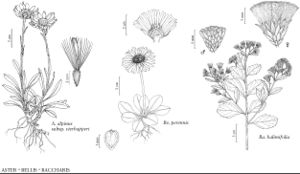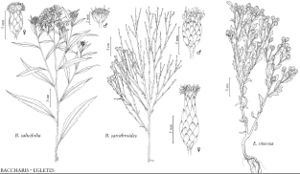Baccharis
Sp. Pl. 2: 860. 1753.
Gen. Pl. ed. 5, 370. 1754.
Perennials, subshrubs, shrubs, or trees, 10–600 cm (dioecious [rarely monoecious], usually glabrous, often resinous; bases woody, rarely rhizomatous). Stems (1–20+) usually erect or ascending, rarely prostrate (usually striate-angled, rarely terete and smooth; usually green), glabrous, glabrate, hispidulous, or villous, often resinous. Leaves cauline (sometimes withering and sparse or absent at flowering); alternate; sessile or petiolate; blades 1-nerved or 3-nerved, linear, lanceolate, ovate, oblong, obovate, or rhombic (usually reduced distally), margins entire or coarsely serrate, faces usually glabrous, rarely hispidulous or villous, often gland-dotted and resinous. Heads (sessile or pedicellate, unisexual) discoid, usually in paniculiform or corymbiform, sometimes racemiform arrays or borne singly. Involucres cylindric to campanulate or hemispheric, 3–9 mm diam. Phyllaries 20–40 in 2–5 series (mid usually green, sometimes red or purple), 1-nerved, ovate to lanceolate, unequal, margins usually scarious, often erose or ciliate, sometimes keeled (midribs evident or not, apices obtuse to acute or acuminate, sometimes keeled), usually glabrous, rarely hispid. Receptacles flat, tholiform, or conic, pitted or smooth (glabrous, tomentose, or glandular), usually epaleate. Functionally staminate florets 10–50; corollas white to pale-yellow, tubes about equal to narrowly funnelform throats, lobes 5, spreading-reflexed, deltate to lanceovate (pappi of 20–40 equal, often crisped and minutely barbellate or distally plumose bristles). Pistillate florets 20–150; corollas whitish, filiform-tubular, lobes 5, spreading-reflexed, ± deltate to lanceovate; style-branches (glabrate, flattened), appendages lacking. Cypselae light-brown, obovoid to cylindric, ± compressed, 5–10-nerved, glabrous or hispid; pappi persistent or falling, of 25–50 whitish to tawny, rarely brownish (elongating and usually surpassing phyllaries in fruit), minutely barbellate, apically attenuate bristles in 1–3 series. x = 9.
Distribution
Mostly New World tropics and warm-temperate regions, especially diverse in South America
Discussion
Species 350–450 (21 in the flora).
Baccharis comprises mostly dioecious shrubs with gland-dotted leaves and is sister to the polygamo-dioecious genera Archibaccharis and Heterothalamus. Sections have been delimited within Baccharis (e.g., D. A. Giuliano 2001; Giuliano and G. L. Nesom 2003; Nesom 1990h, 1998). Species of Baccharis often occur in wet sites such as stream banks, washes, ditches, and marshes. Useful taxonomic characters include habit, branching structure, leaf shape, size, margins, and vestiture, arrangement of heads, and number of nerves on cypselae. Collectors should try to collect both staminate and pistillate individuals to facilitate identification.
Hybridization and introgression have been found between Baccharis halimifolia and B. neglecta, and between B. halimifolia and B. angustifolia. Intermediates between B. thesioides and B. bigelovii have been collected in southern Arizona.
Baccharis is of little economic importance, except for species that are invasive or toxic to livestock (P. E. Boldt 1989). Baccharis is not generally palatable to cattle; it could become the only forage available as a result of overgrazing. In the southwestern United States, B. pteronioides is a hazard to cattle; B. halimifolia, B. angustifolia, and B. glomeruliflora cause similar problems in the eastern United States (G. E. Burrows and R. J. Tyrl 2001). Baccharis pilularis invades overgrazed or eroded rangelands in California and Oregon. Baccharis halimifolia has been introduced in Australia, infesting large areas along the eastern coast, prompting the search for biological control agents (Boldt).
Neomolina F. H. Hellwig is an illegitimate, later homonym that has been applied to species included here in Baccharis.
In key leads, references to pappi are to pappi on cypselae (i.e., in pistillate heads).
Selected References
Lower Taxa
Key
| 1 | Stems hairy, villous, or hispidulous (at least distally among heads) | > 2 |
| 1 | Stems glabrous or glabrate | > 4 |
| 2 | Leaves oblong or oblanceolate, (3–)5–13 mm wide; margins sharply serrate | Baccharis plummerae |
| 2 | Leaves linear-lanceolate to narrowly oblanceolate, 1–4 mm wide, margins serrate or entire | > 3 |
| 3 | Proximal leaves linear-lanceolate, 5–17 × 1–2 mm, not gland-dotted or resinous, absent at flowering; distal leaves reduced, bractlike; Arizona, California, Nevada, Texas | Baccharis brachyphylla |
| 3 | Proximal leaves linear to narrowly oblanceolate, (15–)20–45(–65) × 1–4(–5) mm, gland-dotted (adaxial faces), present at flowering; distal leaves usually well developed; Los Angeles County, California | Baccharis malibuensis |
| 4 | Perennials or subshrubs, stems 10–80 cm (much branched from bases) | > 5 |
| 4 | Shrubs (aerial stems not dying back each year), mostly 60+ cm | > 7 |
| 5 | Pistillate involucres 7–9 mm; phyllaries keeled (midribs dilated); leaves 10–40 × 1–4 mm, margins finely undulate | Baccharis texana |
| 5 | Pistillate involucres 4–5 or 9–14 mm; phyllaries not keeled; leaves 5–30 × 1–2(–7) mm, margins entire, finely serrate, or irregularly dentate, not undulate | > 6 |
| 6 | Pistillate involucres 4–4.5 mm; pappi ca. 4 mm (tawny); leaf margins often irregularly toothed; flowering Jul–Sep; New Mexico, Texas | Baccharis havardii |
| 6 | Pistillate involucres 9–14 mm; pappi 15–20 mm (often brownish); leaf margins entire or finely serrate; flowering Apr–Jun; Arizona, Colorado, Kansas, New Mexico, Oklahoma, Texas, Utah | Baccharis wrightii |
| 7 | Heads in compact racemiform arrays or glomerules (on relatively short lateral branchlets) | > 8 |
| 7 | Heads in ± terminal corymbiform or paniculiform arrays | > 9 |
| 8 | Stems ± terete or weakly striate, glandular, papillose-roughened; leaves clustered in fascicles, blades linear to lanceolate or spatulate, 5–12 × 1–5 mm, entire; heads (on leafy branches) in racemiform arrays | Baccharis pteronioides |
| 8 | Stems sharply striate-angled, glabrous or minutely scurfy; leaves not in fascicles, blades obovate or elliptic to rhombic, 20–60 × 8–40 mm (teeth 1–3 per side distal to middle); heads (sessile or subsessile) often in clusters of 3 | Baccharis glomeruliflora |
| 9 | Plants broomlike (densely stemmed, branches ± parallel); leaves sparse or absent at flowering; heads borne singly (at tips of branches) or (± sessile on lateral branches) in paniculiform arrays | > 10 |
| 9 | Plants bushy or sparingly branched, not broomlike; leaves present at flowering; heads in corymbiform or paniculiform arrays | > 12 |
| 10 | Leaves obovate to broadly oblanceolate, 5–15 mm wide; heads (± sessile on lateral branches) in crowded paniculiform arrays; staminate corollas 2–3.5 mm | Baccharis sergiloides |
| 10 | Leaves linear to narrowly oblanceolate, 1–3 mm wide; heads borne singly or in clusters; staminate corollas 4–5 mm | > 11 |
| 11 | Stems striate, sharply angled; involucres cylindric; phyllaries ovate to lanceolate, apices acute to rounded, glabrous; gravelly or sandy disturbed areas, Arizona, California, New Mexico, Texas | Baccharis sarothroides |
| 11 | Stems smooth, rounded; involucres funnelform; phyllaries lanceolate, narrowly tapered, usually glandular-scurfy; dense coastal chaparral, s California | Baccharis vanessae |
| 12 | Proximal leaves rhombic, coarsely serrate (teeth 2–3 pairs distal to middles); pappi 8–12 mm | Baccharis halimifolia |
| 12 | Proximal leaves not rhombic, usually not coarsely serrate (if serrate, leaves less than 10 mm wide); pappi 3–12 mm | > 13 |
| 13 | Leaves obovate, oblanceolate, or spatulate | > 14 |
| 13 | Leaves linear, lanceolate, elliptic, oblong to narrowly oblanceolate | > 16 |
| 14 | Leaf margins entire; s Florida | Baccharis dioica |
| 14 | Leaf margins coarsely and irregularly dentate or serrate; Arizona, California, New Mexico, Texas | > 15 |
| 15 | Leaves not thickened, margins coarsely serrate or 2-serrate; array leaves reduced to bracts; cypselae 5-nerved; pappi 3–4.5 mm; Arizona, New Mexico, Texas | Baccharis bigelovii |
| 15 | Leaves thickened, margins entire or coarsely dentate (teeth 3–9); array leaves not reduced, often toothed; cypselae 8–10-nerved, pappi 6–9 mm; California | Baccharis pilularis |
| 16 | Leaves linear, narrowly elliptic, or narrowly oblanceolate (1–5 mm wide) | > 17 |
| 16 | Leaves 3–20 mm wide, lanceolate, or oblong to narrowly oblanceolate | > 19 |
| 17 | Leaves linear to narrowly oblanceolate, margins sharply serrate; cypselae 5-nerved | Baccharis plummerae |
| 17 | Leaves linear to narrowly elliptic, margins entire, serrate, or sparsely dentate; cypselae 10-nerved | > 18 |
| 18 | Leaf margins mostly entire; brackish, marshy areas of Atlantic and Gulf coastal plains | Baccharis angustifolia |
| 18 | Leaf margins usually finely serrate (teeth shallow), sometimes nearly entire; disturbed open habitats, c Texas | Baccharis neglecta |
| 19 | Leaves oblong to narrowly oblanceolate, margins entire or coarsely and irregularly ser-rate (teeth 2–3 pairs distal to middles); cypselae 8–10-nerved, pappi 8–12 mm | Baccharis salicina |
| 19 | Leaves lanceolate, linear-oblanceolate, or oblong, margins finely serrate (faces resinous); cypselae 5-nerved, pappi 4–6 mm | > 20 |
| 20 | Plants rhizomatous, colonial; heads in dense, compact, terminal corymbiform arrays; cypselae minutely hispidulous; California, Oregon | Baccharis glutinosa |
| 20 | Plants not rhizomatous, not colonial; heads in loose paniculiform or corymbiform arrays; cypselae glabrous; s and w United States | > 21 |
| 21 | Leaves 30–150 mm, margins entire or finely serrate from bases to apices, teeth blunt-tipped; heads in loose corymbiform arrays; cypselae 0.8–1.5 mm; sw United States | Baccharis salicifolia |
| 21 | Leaves 20–40(–80) mm, margins evenly serrate (teeth spinulose); heads in rounded paniculiform arrays; cypselae 1.5–2.2 mm; Arizona, New Mexico | Baccharis thesioides |

